Romania is a southeastern European country known for the forested region of Transylvania, ringed by the Carpathian Mountains. Its preserved medieval towns include Sighişoara, and there are many fortified churches and castles, notably clifftop Bran Castle, long associated with the Dracula legend. Bucharest, the country’s capital, is the site of the gigantic, Communist-era Palatul Parlamentului government.
The Danube, Europe’s second-longest river, rises in Germany’s Black Forest and flows in a southeasterly direction for 2,857 km (1,775 mi), before emptying into Romania’s Danube Delta. The Carpathian Mountains, which cross Romania from the north to the southwest, include Moldoveanu Peak, at an altitude of 2,544 m (8,346 ft).
Romania is a developing country with a high-income economy, ranking 49th in the Human Development Index. It has the world’s 47th largest economy by nominal GDP. Romania experienced rapid economic growth in the early 2000s; its economy is now based predominantly on services. It is a producer and net exporter of machines and electric energy through companies like Automobile Dacia and OMV Petrom. Romania has been a member of the United Nations since 1955, NATO since 2004 and the European Union (EU) since 2007. The majority of Romania’s population are ethnic Romanian and religiously identify themselves as Eastern Orthodox Christians, speaking Romanian, a Romance language. The Romanian Orthodox Church is the largest and traditional church of the country.
1.Wooden Churches of Maramures
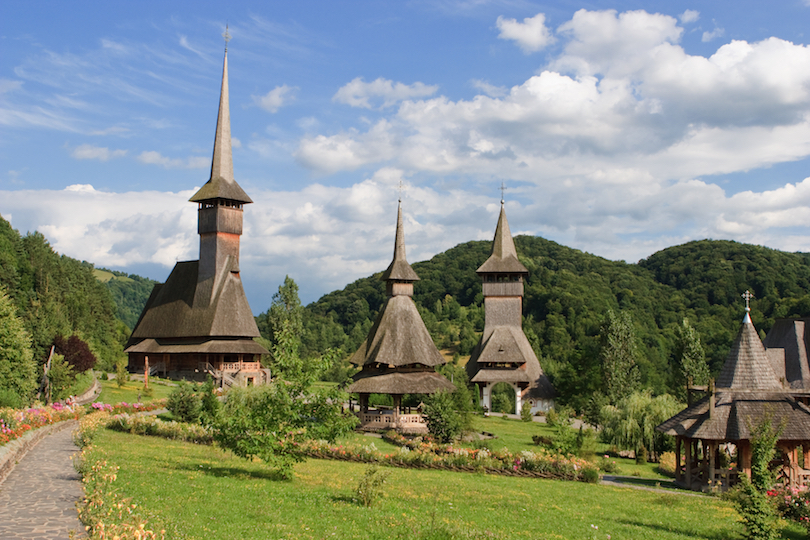
Maramureș is one of the better-known regions of Romania, with autonomous traditions since the Middle Ages. Its well-preserved wooden villages and churches, its traditional lifestyle, and the local colourful dresses still in use make Maramureș as near to a living museum as can be found in Europe.
The wooden churches of the region that still stand were built starting from the 17th century all the way to 19th century. Some were erected on the place of older churches. They were a response to the prohibition against the erection of stone Orthodox churches by the Catholic Austro-Hungarian authorities. The churches are made of thick logs, some are quite small and dark inside but several of them have impressive measures. They are painted with rather “naïve” Biblical scenes, mostly by local painters. The most characteristic features are the tall tower above the entrance and the massive roof that seems to dwarf the main body of the church.
In Maramureș today almost 100 wooden churches still stand, about one third of their total two centuries ago. Besides the extant wooden churches, a major source of knowledge is still saved by a number of practicing senior carpenters with relevant knowledge and skills in traditional carpentry.
Eight were listed by the UNESCO as World Heritage Sites in 1999, for their religious architecture and timber construction traditions. These are: Bârsana, Budești, Desești, Ieud, Plopiș, Poienile Izei, Rogoz, Șurdești.
2.Vaser Valley Forestry Railway
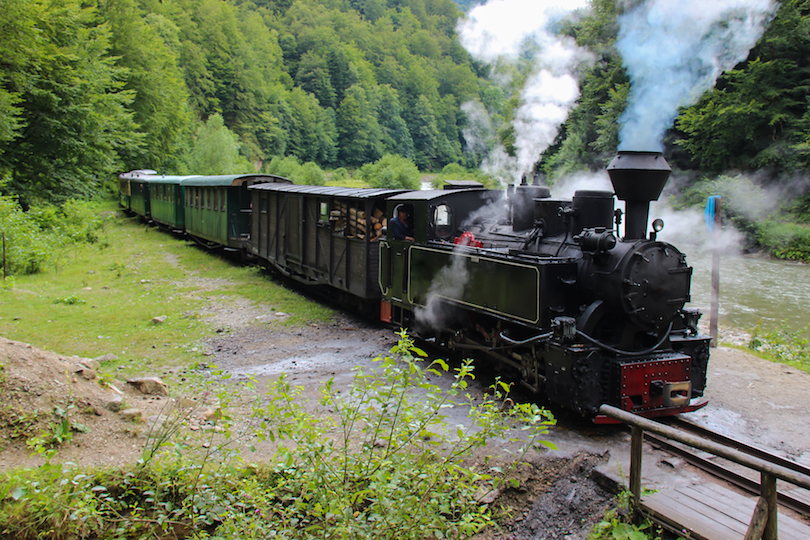
Take a trip back in time as you ride through the forests of the Carpathian Mountains on a steam-powered train. Running along the Vaser River, the Vaser Valley Forestry Railway has been in operation since 1932 when it was used to haul logs from the forest to the mill. Today, it also hauls tourists who like the romance of old, narrow gauge trains traveling through pretty, tree-filled landscapes. The ride stops at Paltin where you have two hours to enjoy the scenery and a picnic lunch.
The most well-known mocăniță runs in the Vaser Valley in Maramureș County. This railway was constructed in the period 1933-1935 and uses a gauge of 760 mm (2 ft 5+15⁄16 in). It was partially destroyed by German troops during World War II, but was rebuilt again. It has primarily been used for logging, and is still used for this purpose, but in 2004 work began on rehabilitating it as a tourist attraction. A Swiss enthusiast who came to Romania in 1987 helped this greatly by starting an organisation for saving the railway: “Hilfe für die Wassertalbahn in Rumänien”.
Several steam engines are used: 764-211 (Măriuța) was built in Berlin by Orenstein & Koppel in 1910; 763-193 (Krauss) was also built in Germany, in 1921; and there are five Romanian locomotives built at Reșița between 1953 and 1955. Diesel engines (built in 1960s-1970s) and other vehicles such as converted minivans also run on the lines. The latter are used by border police, rangers, and others for getting quickly up the mountains.
There are two other branches: along the Novăț Valley (13 km (8.1 mi)) and towards Stevioara (3 km (1.9 mi)). The train can occasionally come off the rails, but at a speed of 10 km/h (6.2 mph) this poses no danger, and experienced passengers help to get the train back on the rails! The Vaser Valley is an exceptionally scenic location, the habitat of many bears and deer, along with many cattle and sheep. The line is run by a private company, Căile Ferate Forestiere [de] (CFF). As well as regular services, trains can be charted by tourists; special services are also run, for instance on New Year’s Eve.
3.Salina Turda
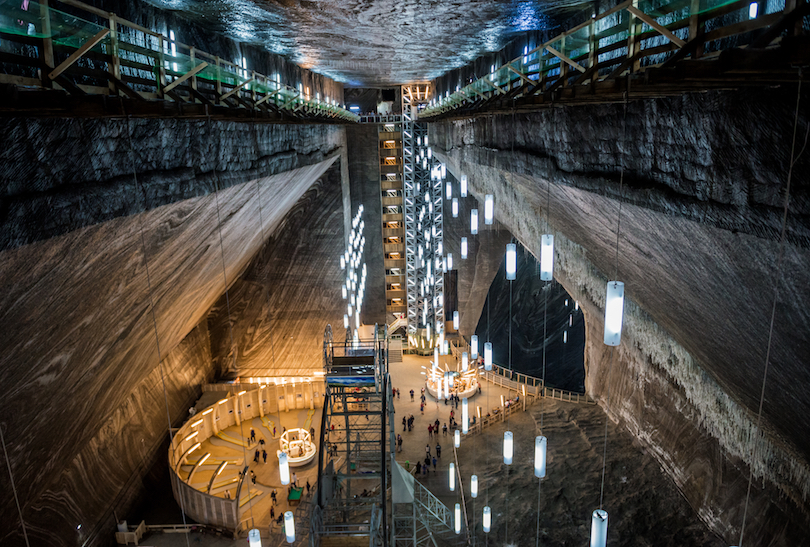
alina Turda is a salt mine in the Durgău-Valea Sărată area of Turda, the second largest city in Cluj County, northwest Romania. Opened for tourists in 1992, the Salina Turda mine was visited by about 618,000 Romanian and foreign tourists in 2017.
Salt was first extracted here during the antiquity. The mine continuously produced table salt from the Middle Ages, the mine being first mentioned in 1075, to the early–20th century (1932).
The first document that speaks explicitly about the existence of a salt mine in Turda dates from 1 May 1271, being issued by the Hungarian chancellery. Documents preserved from the 13th and 14th centuries that refer to the Turda salt mines mention that salines were arranged in the Băile Sărate microdepression and on the southeastern slope of the Valea Sărată. Operating rooms were placed at the sites of current salt lakes from the areas mentioned above. In the 17th century the first salt mining works began on the north-western slope of Valea Valea Sărată, as evidenced by shafts in the dome of the Terezia room. Shortly after, the Sfântul Anton mine was opened, where mining activity continued until the first half of the 20th century.
4.Danube Delta
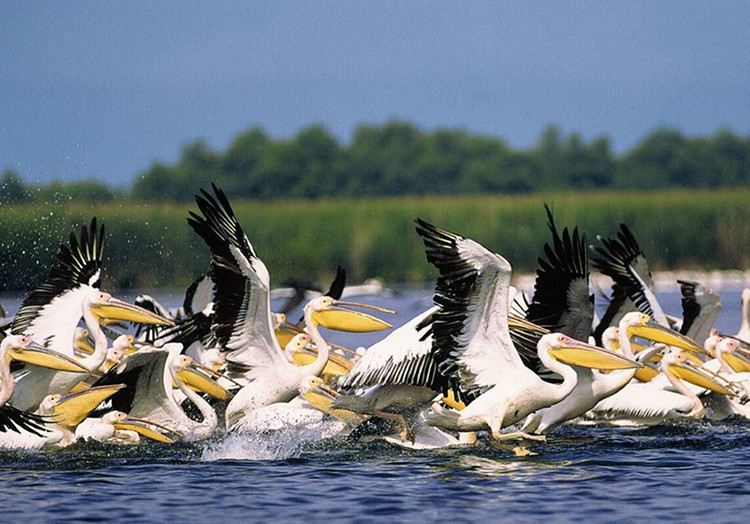
The Danube Delta is the second largest river delta in Europe, after the Volga Delta, and is the best preserved on the continent. The greater part of the Danube Delta lies in Romania, with a small part in Ukraine. Its approximate surface area is 4,152 square kilometres, of which 3,446 km² is in Romania.
Reed plants and floating reed islands (called plaur in Romania) are the most common and well known components of the Danube Delta. Vegetation of this ecosystem consists of the common reed (Phragmites communis) and, on near river banks, mace reed/cattail (Typha latifolia, Typha angustifolia), sedge (Carex dioica, Carex stricta), Dutch rush (Scirpus radicans, Schoenoplectus lacustris), and brook mint (Mentha aquatica), etc. They provide ideal spawning and nesting grounds. The plaur are a mixture of reed roots, grass and soil, usually floating or anchored to the riverbed. As a rule, the reed surrounds the lakes and ponds, and slowly invades the water surface.
This type of ecosystem is noted for its variety and large population of birds, some of them very rare. The most important are the tufted duck (Aythya fuligula), red-crested pochard (Netta rufina), mallard (Anas platyrhynchos), greylag goose (Anser anser), pygmy cormorant (Microcarbo pygmeus), purple heron (Ardea purpurea), great white egret (Egretta alba), little egret (Egretta garzetta), Eurasian spoonbill(Platalea leucorodia), great white pelican (Pelecanus onocrotalus), Dalmatian pelican (Pelecanus crispus), mute swan (Cygnus olor), and glossy ibis (Plegadis falcinellus). A recent and welcomed newcomer is the pheasant (Phasianus colchicus).
Among the mammals, there is the Eurasian otter (Lutra lutra), European mink (Mustela lutreola), little ermine (Mustela erminea aestiva), wild boar (Sus scrofa), and wild cat (Felis silvestris), in winter the European hare (Lepus europaeus) and, on the brink of disappearing from the delta, the wolf and the fox. The East Asian raccoon dog (Nyctereutes procyonoides), bizam/introduced muskrat (Ondatra zibethica), and to some extent South American nutria (Myocastor coypus), are recent species that have successfully adapted.
5.Transylvanian Alps
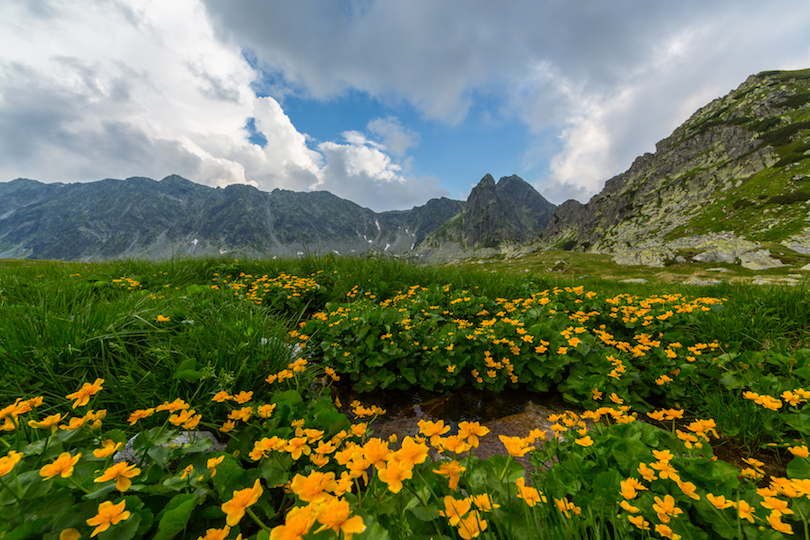
The Southern Carpathians are the second highest group of mountains in the Carpathian Mountain range (after Tatra), reaching heights of over 2,500 meters. Although considerably smaller than the Alps, they are classified as having an alpine landscape. Their high mountain character, combined with great accessibility, makes them popular with tourists and scientists.
They cover the part of the Carpathian Mountains located between the Prahova River in the east and the Timiș and Cerna Rivers in the west. To the south they are bounded by the Balkan mountain range in eastern Serbia.
The exception is Mount Moldoveanu, at 2,544 meters (8,346 feet), the highest point in Romania. The rugged mountains, dotted with sheep-filled meadows with wildflowers, offer some pretty good hiking in the summer and skiing in the winter. Couch potatoes can visit a mist-shrouded Gothic castle instead as they hunt for legendary vampires on their own turf.
6.Merry Cemetery
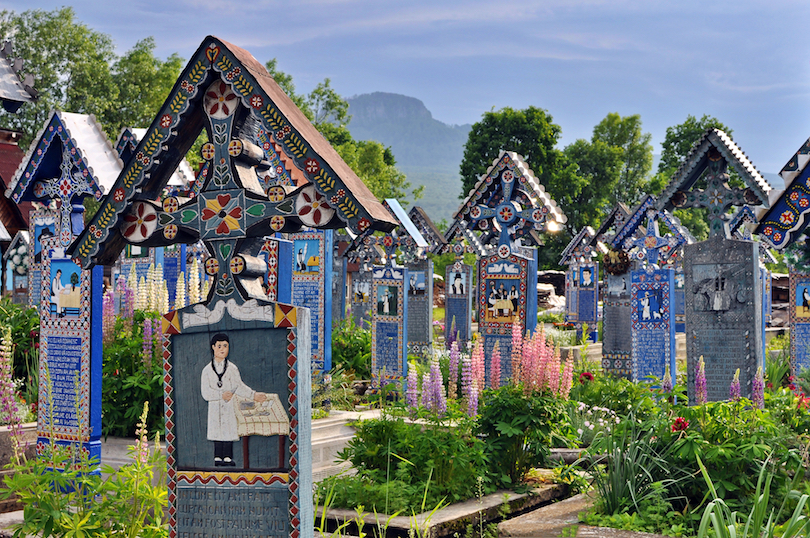
The Merry Cemetery is a cemetery in the village of Săpânța, Maramureş county, Romania. It is famous for its brightly coloured tombstones with naïve paintings describing, in an original and poetic manner, the people who are buried there in addition to scenes from their lives.
he unusual feature of this cemetery is that it diverges from the prevalent belief, culturally shared within European societies – a belief that views death as something indelibly solemn. Connections with the local Dacian culture have been made, a culture whose philosophical tenets presumably vouched for the immortality of the soul and the belief that death was a moment filled with joy and anticipation for a better life .
A collection of the epitaphs from the Merry Cemetery exist in a 2017 volume called Crucile de la Săpânța, compiled by author Roxana Mihalcea [1], as well as in a photography book titled The Merry Cemetery of Sapanta by Peter Kayafas.
7.Peles Castle
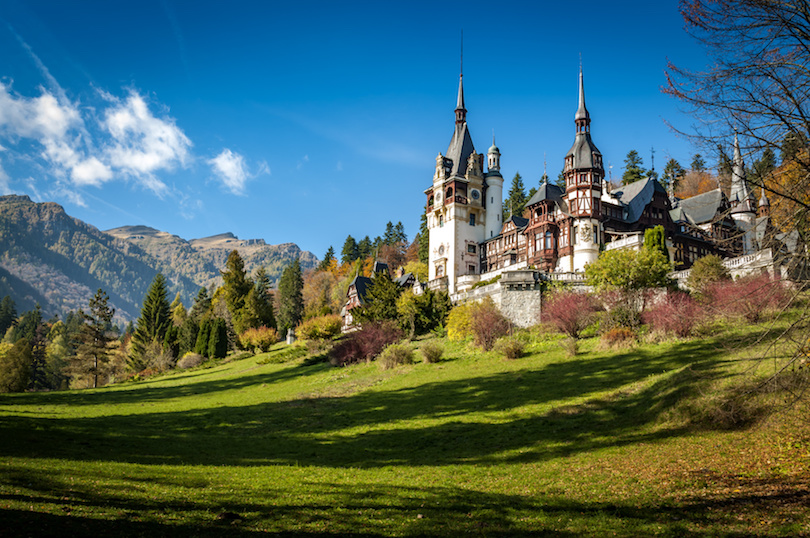
Peleș Castle is a Neo-Renaissance castle in the Carpathian Mountains, near Sinaia, in Prahova County, Romania, on an existing medieval route linking Transylvania and Wallachia, built between 1873 and 1914. Its inauguration was held in 1883. It was constructed for King.
Public visits are made within guided tours. One of the tours is limited to the ground floor, another adds the first floor and the complete tour includes the second floor.Admission is charged, and there is an additional photography fee. The visiting hours are from 9 am to 5 pm. Wednesday through Sunday. On Tuesdays the hours are 11 am to 5 pm. The castle is closed on Mondays. These visiting hours are subject to change by the Romanian Culture Ministry. The castle is closed in November each year for maintenance and cleaning.
The most notable grand rooms are:
Holul de Onoare (The Hall of Honour) was finished completely only in 1911, under the guidance of Karel Liman. It spreads over three floors. Walls are dressed in exquisitely carved woodwork, mostly European walnut and exotic timbers. Bas-reliefs, alabaster sculptures, and retractable stained glass panels complete the decor.
Apartamentul Imperial (The Imperial Suite) is believed to be a tribute to the Austrian Emperor Franz Joseph I, who visited the palace as a friend of the Romanian Royal Family. Hence, decorator Auguste Bembe preferred the sumptuous Austrian Baroque in style of Empress Maria Theresa. A perfectly preserved five-hundred-year-old Cordoban tooled leather wall cover is the rarest of such quality.









